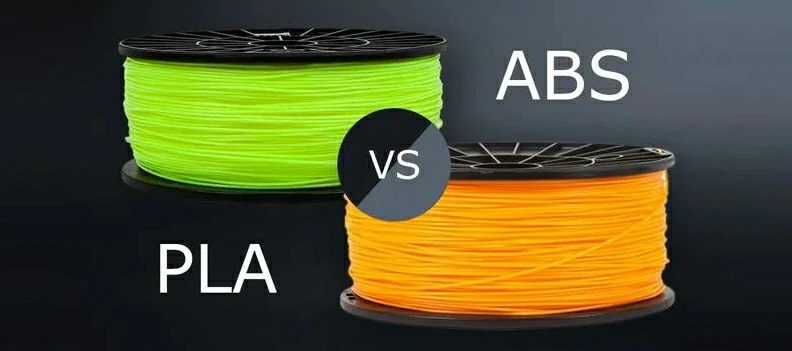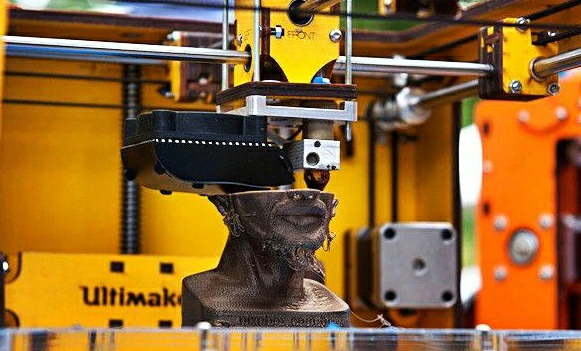3D printing can be applied to various fields in numerous ways. When it comes to 3D printing polymers, ABS and PLA are the two most common materials, often sparking debates over which one to choose.
For beginners or enthusiasts using FDM 3D printing, determining which material is more suitable can be challenging. To address this question, we need to carefully compare and understand the characteristics and differences between ABS and PLA, aiding you in selecting the material that best fits your needs.
What Is ABS and PLA?

PLA, or Polylactic acid, stands out for its eco-friendliness, being made from renewable plant sources like corn or sugarcane. It’s biodegradable and easy to use, making it a go-to for beginners. PLA is often chosen for its versatility in complex prints and is commonly used in prototyping and architectural models.
On the other hand, ABS, or Acrylonitrile Butadiene Styrene, offers durability and impact resistance, making it suitable for functional parts and prototypes that require strength. It’s been a staple in 3D printing since the early days and is commonly used in industrial applications.
ABS vs PLA: Differences and Comparison
ABS and PLA differ in several aspects. The table below compares the material characteristics of ABS and PLA filaments.
| Properties | ABS | PLA |
|---|---|---|
| Chemical name | Acrylonitrile Butadiene Styrene | Polylactic acid |
| Printing temperature | 210-240℃ | 180-200℃ |
| Melting point | 173 ℃ | 200 ℃ |
| Printing odor | Strong pungent odor | Candy scent |
| Heating plate temperature | Above 80℃ | Use at 60℃ |
| Elongation | 6% | 50% |
| Density | 1.3 g/cm³ | 1.4 g/cm³ |
| Tensile strength | 37 MPa | 60 MPa |
| Impact on print head | Less prone to clogging hotend | Prone to clogging hotend |
| Material characteristics | Good toughness | High strength, environmentally friendly material |
| Biodegradable | No | Yes |
| Impact strength (Notched izod, J/m) | 200 – 215 | 96.1 |
| Brittle | No | Yes |
| UV Resistant | Yes | No |
| Shrinkage | Prone to shrinkage | Minimal |
ABS is relatively easy to print but prone to warping and detachment due to shrinkage when cooled. It’s suitable for high-temperature environments but requires good ventilation. PLA is easy to print with minimal shrinkage, making it ideal for large objects and on-site printing. However, it’s not suitable for high temperatures and is brittle. Choose ABS for durability and heat resistance, while PLA is biodegradable and easy to work with.
ABS vs PLA: Heat Performance
Heat performance directly influences the behavior and performance of materials under different temperature conditions. The table below compares the heat performance indicators of ABS and PLA.
| Heat Performance | ABS | PLA |
|---|---|---|
| Melt flow index (MFI) | 9.7cm³/10min | 10.3 cm³/10min |
| Glass transition temperature | 105℃ | 60-65℃ |
| Ultimate temperature | 110-125℃ | 70-80℃ |
| Melting temperature | 210-240℃ | 160-190℃ |
| Printing temperature | 230-250℃ | 190-220℃ |
| Recommended bed temperature | 80-120℃(This requires the use of a heated bed) | 50-70℃(Not mandatory to use a heated bed) |
ABS has a higher glass transition temperature (Tg) and melting point compared to PLA. This allows ABS to maintain its shape and rigidity at higher temperatures, making it suitable for applications that require thermal stability. PLA, on the other hand, has a lower Tg and is more prone to softening and deformation at elevated temperatures.
ABS vs PLA: Post-Process
These two materials exhibit noticeable differences in the smoothness of printed parts—PLA components tend to be shinier, while ABS appears more matte.
However, post-processing ABS 3D prints is usually easier than PLA. This is mainly because ABS offers higher durability and adaptability to mechanical manipulation.
Moreover, if you want to achieve a smooth and glossy surface on ABS, you can use acetone vapor smoothing. Acetone, as a colorless liquid, is a good solvent for ABS, rapidly dissolving tiny particles on the surface to make the part as smooth as glass. However, it cannot be used with PLA.
Although this method doesn’t apply to PLA, fortunately, there are alternative solutions for PLA material. We also have similar post-processing methods available. By using THF (Tetrahydrofuran) for manual polishing, although the effect may not be as significant as acetone treatment for ABS, it can still improve the surface smoothness of PLA parts to some extent.

ABS vs PLA: Printability
Both ABS and PLA are widely used in fused deposition modeling (FDM) 3D printing. However, they have different printing characteristics that affect the printability and quality of the final product.
ABS requires a higher printing temperature compared to PLA, typically ranging from 220°C to 260°C. This higher temperature ensures good layer adhesion and minimizes warping and shrinkage. However, it also increases the risk of heat-related issues such as nozzle clogging and material degradation. PLA, on the other hand, has a lower printing temperature range of 180°C to 220°C. This makes it easier to print with and less prone to heat-related issues.
For both materials, the issue of poor adhesion between the first layer and the print bed leading to warping is common. The most common solution is to cover the print bed with tape, adhesive, or spray. For tape, we recommend using Kapton tape, but masking tape also works well.
ABS vs PLA: Cost
The prices of both types of filaments are roughly similar. However, specialty filaments, such as PLA blended with wood or other materials, are typically more expensive.
Generally, the starting price for 1 kg of PLA and ABS filament is around $18, but the average price for basic filament spools seems to be around $20. Of course, prices can vary if you’re looking for higher-quality filament or special features like multi-color or professional-grade options.
ABS vs PLA: Biodegradability
PLA is biodegradable, as it’s made from plant-based materials. However, these conditions for biodegradation only exist in industrial composting facilities, which require high temperatures and exposure to specific microbial environments. In natural settings, PLA may take up to 80 years to fully degrade.
ABS, on the other hand, is non-biodegradable and may take hundreds of years to completely degrade. However, it can be recycled.
Over time, both PLA and ABS can degrade when exposed to sunlight or moist environments.

ABS vs PLA: Mechanical Properties
PLA is brittle and has a higher surface hardness. It tends to break more easily when bent. Objects made from this material can be cut, sanded, painted, and glued; however, unlike ABS, they cannot be treated with acetone to improve the smoothness of the printed object’s surface.
ABS parts are tougher than PLA parts and are more likely to bend rather than break under pressure. ABS also has better ductility, making post-processing easier.
ABS vs PLA: Applications
ABS is commonly used in applications that require durability, toughness, and thermal stability. It is suitable for making prototypes, functional parts, and end-use products in industries such as automotive, aerospace, and consumer electronics. ABS is also a popular choice for making toys and other products that require a smooth and glossy surface finish.
PLA is gaining popularity in applications that prioritize environmental friendliness and sustainability. It is commonly used in making prototypes, concept models, and educational toys. PLA is also suitable for applications requiring a matte finish or where the visual appearance is less critical.

ABS vs PLA: Print Speed
The printing speed of both materials is generally similar. PLA typically prints at a speed of 60 mm/s, while ABS usually prints within the range of 40-60 mm/s, and achieving speeds higher than this can be challenging.
ABS vs PLA: Part Accuracy
3D printing with ABS is more complex than PLA. Because ABS requires higher temperatures to melt, there are more abrupt changes during part cooling. This thermal shrinkage can lead to part deformation, with warping being one of the most common issues.

Compared to ABS, PLA is a material that is much easier to 3D print with and can produce parts with stable dimensions.
ABS vs PLA: Strength
ABS has higher flexural strength and a greater elongation at break. This means that even when facing some degree of deformation or stress, ABS can maintain the integrity and stability of its structure.

In contrast, PLA, with its relatively weaker elongation and sensitivity to physical stress, is less suitable for applications requiring sustained physical loads or exposure to extreme environments.
However, if you’re looking for a 3D printing material suitable for creating customized parts that don’t need to withstand excessive physical stress or extreme environmental conditions (such as UV radiation and high temperatures), then PLA would be a good choice.
When to Use a ABS and PLA

It depends on two aspects of your specific situation: first, your printing skills and ability to handle the printing difficulty, and second, what kind of final product you desire.
Your Printing Skills?
Printing with PLA is generally easier compared to ABS. If you’re a beginner or have lower printing skills and you want your product to have environmental benefits, you can choose PLA. PLA has lower printing difficulty and can biodegrade in natural environments.
However, if you still want to choose ABS for printing, precise parameter settings and fine printing skills are required. The printing temperature for ABS is generally between 220-250 ℃, which is higher than PLA’s printing temperature (180-220 ℃).
What Are You Printing?
PLA softens easily at high temperatures, making it unsuitable for making parts that need to withstand high temperatures.
PLA is a biodegradable material, making it the preferred choice if you are very concerned about environmental impact.
ABS has better heat resistance and is suitable for making heat-resistant parts.
If you want your product to have higher strength and toughness and can tolerate higher printing difficulty, you can choose ABS.
Conclusion
ABS and PLA are two distinct materials with different properties and characteristics that make them suitable for different 3D printing applications. Ultimately, the choice between ABS and PLA depends on the specific requirements and constraints of the 3D printing project.
BOYI is your comprehensive 3D printing service expert, catering to all your needs in one place. We offer competitive SLA, SLM, and SLS printing services.
With a trained and experienced team of experts, we’re ready to provide you with comprehensive technical support, design guidance, and case study analysis at any time. When it comes to choosing between PLA and ABS materials, our team will offer you professional advice and solutions.
No matter which printing material you choose, BOYI will provide you with fast and cost-effective quotes, ensuring you get the parts you need in the shortest possible time while maintaining the highest service quality. Contact us now and let’s start your project together!
Put your parts into production today
All uploads are secure and confidential.
FAQ
ABS filament suffers from its tendency to melt and burn, emitting potentially harmful fumes. While flame-retardant additives can mitigate this, its heat resistance is inherently limited, with a melting point typically ranging from 200-240°C.
When comparing ABS and PLA, each has its strengths. PLA is more vulnerable to brittleness and UV degradation, but it prints more smoothly and less prone to warping. For rapid prototyping, PLA shines, while ABS excels in functional applications.
In summary, PLA reigns supreme over ABS in terms of safety, owing to its eco-friendly credentials. Derived from renewable resources, PLA is biodegradable and boasts a reduced carbon footprint, ensuring safer usage across various applications.
Tagged: Materials Guide

This article was written by engineers from the BOYI team. Fuquan Chen is a professional engineer and technical expert with 20 years of experience in rapid prototyping, mold manufacturing, and plastic injection molding.




